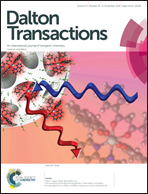Synthesis, characterization, and in vitro evaluation of new coordination complexes of platinum(ii) and rhenium(i) with a ligand targeting the translocator protein (TSPO)†
Abstract
The 18 kDa translocator protein (TSPO) is overexpressed in many types of cancers and is also abundant in activated microglial cells occurring in inflammatory neurodegenerative diseases. The TSPO-selective ligand 2-(8-(2-(bis-(pyridin-2-yl-methyl)amino)acetamido)-2-(4-chlorophenyl)H-imidazo[1,2-a]pyridin-3-yl)-N,N-dipropylacetamide (CB256), which fulfills the requirements of a bifunctional chelate approach, has been used to synthesize coordination complexes containing either Pt (1) or Re (3), or both metal ions (2). The new metal complexes showed a cellular uptake markedly greater than that of the precursor metallic compounds and were also able to induce apoptosis in C6 glioma cells. The good cytotoxicity of the free ligand CB256 towards C6, A2780, and A2780cisR tumor cell lines was attenuated after coordination of the dipicolylamine moiety to Pt while coordination of the imidazopyridine residue to Re reduces the affinity towards TSPO. The results of the present investigation are essential for the design of new imidazopyridine bifunctional chelate ligands targeted to TSPO.


 Please wait while we load your content...
Please wait while we load your content...